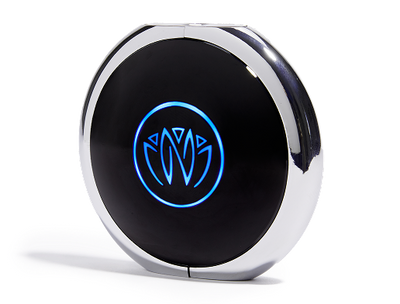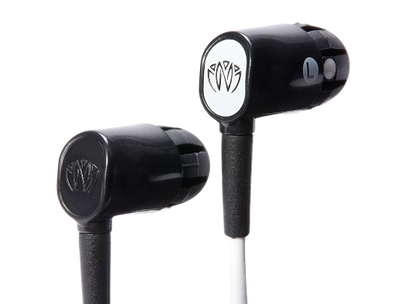As silly as the term might sound, ear tickling therapy could be the key to unlocking a healthier, well-balanced nervous system and even reducing the effects of aging. And today, we're going to tell you why. We'll cover the basics of ear tickling, including what it means, how it works, and how you can try it for yourself.
The ear has long been considered the gateway to the nervous system—this is because a branch of the vagus nerve is accessible through the ear.
Before we explore the wonders of ear tickling therapy, let's cover the basics of the vagus nerve first, as this is a critical component of understanding what makes the ear the gateway to the nervous system.
What is the vagus nerve?
The vagus nerve is the longest nerve in the body. Beginning at the brain, it then travels down behind the ear, and then onto every major organ in the body. As for what this nerve is responsible for? Well, it serves a number of important functions, including communicating sensory information between the brain and the organs.
This special nerve is a critical component of the parasympathetic nervous system (a subdivision of the autonomic nervous system) responsible for regulating bodily functions which are outside of voluntary control.
So, next time you're in "fight or flight" mode and feeling panicked and on edge, it will be your vagus nerve that's responsible for restoring a more relaxed, balanced state. With the help of your vagus nerve, your mind becomes calmer, clearer, and it reacts in a healthier way to stress.
The vagus nerve is crucial for activating your relaxation response, helping to regulate tension, and developing resilience. As such, the stronger your vagus response, the more likely you may be to recover quickly from stressful events.
Vagus nerve stimulation

Purposely stimulating the vagus nerve isn't a new practice. For centuries, people have been practicing meditation, yoga, chanting, and even cold exposure for vagus nerve stimulation (VNS). As a result, they can experience effects like a brighter mood, better sleep, and promoting relaxation.
There are also more invasive methods of VNS, including surgical implantation of vagus nerve stimulation devices. These tend to be utilized for medical purposes (including treating seizures) as opposed to promoting well-being in general.
One of the most effective and non-invasive methods of VNS is transcutaneous vagus nerve stimulation. This means stimulating the vagus nerve through the skin, rather than from within the body.
And can you guess where the vagus nerve can be accessed through the skin? That's right—behind the ear. And thus, we arrive at ear tickling therapy.
What is Ear Tickling Therapy?
So, we know the vagus nerve plays a critical role in balancing the nervous system, promoting calm and well-being, and improving how we respond to stress. We also know the vagus nerve can be accessed near the ear. Accessing the vagus nerve with the intent to experience a variety of benefits is...drumroll please...known as ear tickling therapy.
But this isn't the kind of tickling you might be thinking of. Instead, ear tickling therapy refers to the use of a gentle electrical current applied to the area behind the ear where it can stimulate the vagus nerve. In addition to the benefits (including promoting well-being) researchers are finding it could also be the key to unlocking anti-aging benefits.
(The anti-aging potential of vagus nerve stimulation isn't its only exciting and promising use. Many people also find it's an incredibly useful tool in their toolkit for managing anxiety. Take a look at this post to see what we mean: Dealing with Anxiety Using tVNS)
The nervous system and aging
When most of us think of aging, images of wrinkles and grey hair come to mind. But aging affects us in a number of other ways, including many we don't see. One such change is the impact aging has on our nervous systems.
"Ageing is associated with changes in autonomic nervous system function and is characterized by increases in sympathetic and decreases in parasympathetic nervous activity. Such autonomic changes can be detrimental to heart function, emotion, mood and gut function, and may play a role in a range of conditions that increase in prevalence with ageing, including heart failure, hypertension and depression. These conditions are typically accompanied with increases in medication consumption and decreases in quality of life (QoL)."
When we consider the effects of aging on the nervous system, it's no surprise there's a focus on protecting and improving nervous system function as much as possible. And now, ear tickling therapy is in the running for the best way to do this!
Ear Tickling Therapy and Its Anti-Aging Effects
Recently, the conversation around ear tickling therapy and its potential anti-aging benefits have become increasingly popular. This is largely due to a 2019 from The University of Leeds. This study highlights the potential benefits and effects of transcutaneous vagus nerve stimulation in individuals aged 55 years or above.
Here's what the results found:
"Two weeks of daily tVNS improved measures of autonomic function, and some aspects of QoL, mood and sleep. Importantly, findings showed that improvements in measures of autonomic balance were more pronounced in participants with greater baseline sympathetic prevalence. This suggests it may be possible to identify individuals who are likely to encounter significant benefits from tVNS."
This means the effects of tVNS are even more exciting and impressive than many of us have realized. A healthier nervous system including one that's more resilient to the effects of aging comes with a number of benefits.
To name a few...
"Preventing or reducing age-related changes in autonomic balance may therefore improve health in older individuals, as well as increase their independence, QoL and mood (particularly depression). Potential benefits include reduced risk of mortality and reductions in the need for medication and/or hospitalization."
(Speaking of mental health, take a look at this post to read about 10 different hacks for improving it, including vagus nerve stimulation)
Try Ear Tickling Therapy for Yourself
There's no question the findings of this study are exciting. But even if you're not focusing on the anti-aging potential of tVNS, you might be eager to explore its other benefits. Luckily, doing so takes a lot less work than you might think. And no, you don't need to join a study either.
Instead, you can unlock the potential benefits of tVNS with a pair of Xen by Neuvana headphones. But these aren't just any headphones—they're vagus nerve stimulating headphones.
Xen by Neuvana is a patented electronic device. It delivers gentle micropulses through headphones directly to the vagus nerve located in your ear...your very own form of ear tickling therapy right in the palm of your hand. It pairs wirelessly to your Neuvana app, where you can customize your sessions. The result? Improved focus and calm anywhere you are.
Whether you're interested in the potential anti-aging effects for your nervous system or creating a healthier, more resilient nervous system in general, there's no doubt tVNS can be a helpful tool for reaching those goals.
Click here to learn more about the science of tVNS or shop Xen by Neuvana here.
Did you learn a lot about the nervous system in this post?
Here are three more posts to read next:





